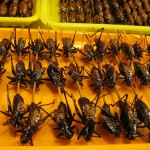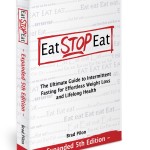

True Paleo Protein 5 Comments Wednesday, July 10th, 2013 Guest post written by: Judah BouletPhoto by Tim Olson“Cricket is my reason for living.” Harold Larwood, a professional cricketer in the 20’s and 30’s said this in reference to the sport he so loved. As we look forward to the later half of the 21st century, with global populations reaching 9 billion people, far surpassing the earth’s carrying capacity, could it be that Cricket, the insect, be the reason for all of us living? As the world’s population grows the demands for a sustainable protein source to meet the nutritional needs of the worlds inhabitants, in all corners of the globe, while maintaining some sense of wilderness presence, is absolutely necessary.Entomophagy is the practice of eating insects. This practice happens to be widely accepted and normal in most corners of the world, by many cultures, outside of the US, Canada, and Europe. What many do not know is that insects happen to be a highly valuable source of nutrition, and relatively inexpensive to raise. They also represent a potential highly sustainable source of protein to meet the world’s rising populations. They are easy to raise, do not take up much space, do not make much waste, and do not require much biomass to grow, and there are thousands of varieties each with a different taste.While you may initially scoff at eating an insect, many of you have probably eaten a close relative of all insects, and actually call it a delicacy. The next time you have King Crab or Lobster, realize you are eating an arthropod, just like a cricket. Arthropods are arthropods, whether it is the $40 lobster in front of you or the crickets outside. You may consider insects disgusting, scavengers of the earth, but realize for a moment what those lobsters and crabs are doing on the ocean floor. It’s not so sexy.Insects also happen to be a true paleo protein. If we look at the human family tree and we look to our closest primate relatives, we see that many of these species ate insects. It is easy to extrapolate to the conclusion that in the evolution of our species, insects were a part of the diet. If we look to modern day hunter gatherer tribes, we also see a reliance on insects as part of their nutrition and diet. If we want to truly “eat paleo”, should we at least not consider bugs?Just like any common day American protein source, there is a range of nutritional components. Some insects have a greater percentage of fat, compared to protein, and all have a low carbohydrate profile. (See table 1) While relative amounts vary from insect source to insect source, insects also provide a source of bioavailable iron, zinc and calcium.5 Some sources also have high content of the omega 3, alpha-linolenic acid.6Table 1This table taken from http://www.ent.iastate.edu/misc/insectnutrition.html Insect Protein (g) Fat (g) Carbohydrate Calcium (mg) Iron (mg) Giant Water Beetle 19.8 8.3 2.1 43.5 13.6 Red Ant 13.9 3.5 2.9 47.8 5.7 Silk Worm Pupae 9.6 5.6 2.3 41.7 1.8 Dung Beetle 17.2 4.3 .2 30.9 7.7 Cricket 12.9 5.5 5.1 75.8 9.5 Grasshopper 20.6 6.1 3.9 35.2 5.0 Grasshopper 14.3 3.3 2.2 27.5 3.0 June Beetle 13.4 1.4 2.9 22.6 6.0 Caterpillar 28.2 N/A N/A N/A 35.5 Caterpillar 9.7 N/A N/A N/A 1.9 Termite 14.2 N/A N/A N/A 35.5 Weevil 6.7 N/A N/A N/A 13.1 Beef (Lean Ground) 27.4 N/A N/A N/A 3.5 Fish (Broiled Cod) 28.5 N/A N/A N/A 1.0 While each insect has its own nutritional profile, biochemical analysis and comparison of the protein amino acid breakdown of cricket protein shows that it is a complete protein source and contains all essential amino acids. Comparing ground crickets, with no chemical processing needed, to three traditional pure protein sources, the profile stacks up rather sharply.(Table 2)Table 1 The amino acid profiles of whole crickets are comparable per 100g to other protein isolates in regard to AA Breakdown. per 100 g values listed in grams NOW Brand Soy Isolate Now Brand Egg White Now Brand Whey Concentrate Whole Ground Cricket L-Alanine 6.00 2.61 3.20 5.55 L-Arginine 4.20 4.58 1.69 3.68 L-Aspartic Acid 8.38 7.04 6.59 6.29 L-Glutamic Acid 10.50 11.62 11.99 9.07 Glycine 2.63 2.53 1.10 3.62 L-Histidine 1.75 1.62 1.00 1.94 L-Isoleucine 3.63 2.96 3.80 3.09 L-Leucine 6.03 4.93 0.04 5.52 L-Lysine 4.70 3.80 5.77 4.79 L-Methionine 3.93 0.77 1.63 1.93 L-Phenylalanine 4.25 3.17 1.96 2.86 L-Proline 2.83 3.10 3.83 4.50 L-Serine 5.13 3.17 3.08 3.72 L-Threonine 3.48 2.32 4.25 2.75 L-Valine 5.17 3.03 3.39 4.42 L-Tryptophan 1.63 n/a 1.01 0.6* *all cricket data taken from Wang et al
More:
Robb Wolf – True Paleo Protien: Insects





 For now classes are 6pm and 640pm at 2840 Wildwood st in the Boise Cloggers studio.
Book your class NOW!
click this ==>
For now classes are 6pm and 640pm at 2840 Wildwood st in the Boise Cloggers studio.
Book your class NOW!
click this ==>








